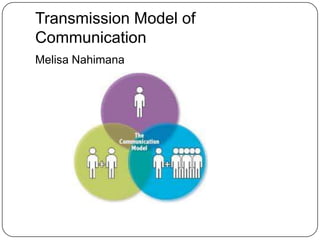
Transmission model of communication
- 1. Transmission Model of Communication Melisa Nahimana
- 2. Definition A model invented by Shannon and Weaver Model that was invented in 1949 It has been considered a mathematical interpretation of how communication between different parties is ought to function The purpose of the model is to communicate to one another According to the book Communication Theories in action, communication can be defined as “ a systematic process in which individuals interact with and through symbols to create and interpret meanings.” The transmission model of communication helps us assist how communication works
- 3. Elements of the Transmission Model Sender Encoding Message Channel Receiver Decoding Feedback Noise
- 4. Sender Source of the message Responsible for the encoding of a message Responsible for the success or failure of the sending of a message Accountable for accurate information delivery Chooses the transmission channel of the message Initially leads the argumentative environment Presents in front of an audience Sender presents one out of multiple truths By representing a certain truth, the sender sets a standard for a new idea Sender has to follow the continuum of argumentative certainty ( Marteney, 14)
- 6. Idea and thought being reflected
- 7. Information is based on the production of the sender
- 8. Dependant on the sender
- 9. Transformation if idea into the universal reality , e.g. virtual reality
- 10. Perception process ( Marteney, 71) to come t light during the encoding process
- 12. Channel
- 13. Channel Means for the sender to communicate to the receiver Outlet to send a message back from the receiver to the sender ( also known as feedback) Usage as avenue to conversean argument in the area of critical thinking Path for an individual to express oneself verbally or non-verbally To stimulate one of the five senses: sight, sound, touch, taste, and smell Channels contain the right time, place and occasion ( Marteney, 85) Consideration of word choice, ambiguity, definition and intensity( Marteney, 85) Meanings reflected through channel, either denotative or connotative The critical thinker must therefore use the channel eloquently, so that his or her argument is going to be admitted as a reliable truth
- 15. The end of the communication channel
- 16. Decoded message to be listened and observed by the recipient
- 17. To be beneficiary of critically analyst information from the dispatcher
- 18. Eligible to send back feedback
- 19. Meaning of the message to be understood by receiver
- 20. Receiver to be target
- 22. Feedback Information send back to the source Part of a cause and effect chain Verbal and nonverbal manner of respond Comes from the receiver of a message Purpose is to modify the sender’s idea or implication Feedback can include the same elements of the message: claims and contentions Claims and contentions supported by evidence and reasoning
- 23. Noise Anything that disrupts or distorts the communication process Verbal and nonverbally Noise does not necessarily have to come from the audience or anyone in the room Maybe viewed as negative disruption Noise may also be a source of an indirect message-e.g. the matter of the orator may not be appropriate for the audience
- 24. Transmission Model in Critical Thinking Through the lenses of the Transmission Model, a truth can be communicated to an audience The matter mathematically to be explained through the transmission model, which should be followed by a qualified persuader Reasoning needed to be understood for all parties included Foundations of Knowledge to be essential on Decision-making situations- which is the reason why the speaker must know what he or she is conversing about Argumentative Environment to be created by the speaker with the assistance of the Transmission Model Inclusion of the audience by understanding its context, and accepting its feedback should be incorporated in the critical thinking process